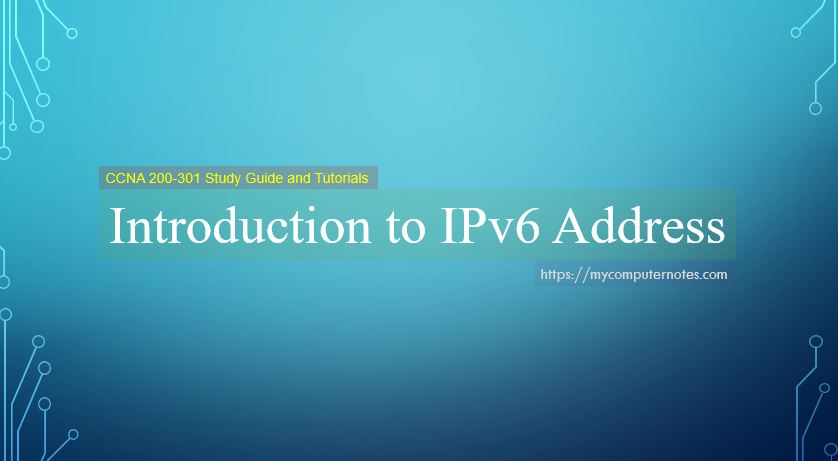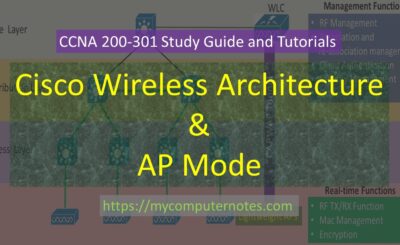In this tutorial, we will discuss introduction to IPv6 addressing. IPv6 stands for Internet Protocol Version 6. It is the latest version of IP protocol in networking. IPv6 is introduced to overcome the rapid depletion of IPv4 addressing. IPv4 is only 32 bits length while IP version 6 has 128 bits long address length. In this section, we will cover the major features of IPv6, why IPv6 needed, IPv6 addressing format, Types of IPv6 addressing scheme, IPv6 address structure, interface ID, global unicast address, unique local address, and so on.
Features of IPv6 Addressing
The IP v6 is loaded with bundles of features. The follwoing are some of the important features of IP v6.
- Larger Addressing space
- Simplifed header length as compared to IPv4
- Enhanced security with in built IPsec
- Seamless mobility
- Auto configuration
- End to end connectivity
- Anycast addressing types
- NO broadcast anymore
Why IPv6 Address needed
Internet is growing day by day. Every device that is connected to the Internet requires a unique address to identify itself in a network. This unique address is called an IP address.
Since the advent of Internet, IP v4 has taken the responsibility of addressing a device when it is connected to the network. during the recent decades the enormous growth of internet users led to the rapid exhaustion of IP v4 address. The numerous techniques like sybnetting, CIDR, NAT are adopted to control the IPv4 depletion .However they are all temporay solution.
The introduction of IP v6 seems to to be the permanent solution in respect of logical addressing scheme. IP v6 is more flexible and efficient with 128 bits address length.
Types of Addressing modes in IPv6
- Unicast
- Multicast
- Anycast
Unicast
Unicast addressing mode is referred to the one to one communication betweet source and destination. The source host is equopped with the destinatiomn address that uniquqly defines the destination host in network. the router or switch forwards to that unicast IP packets to the destination host only.
Multicast
Multicast in networking is a method os sending Packets from a single device to the mulitple destination simultameously.
Multicast addressing mode allows the device to transmit datagrams to a specified set of multicast group
Anycast
Anycast in IP v6 addressing can exist in multiple interfaces at different locations. Anycast address can exist more than once in anywhere in the entire network. Nowadays most of the internet services and web services are located in multiple places to provide seamless and fast services to the clients or customers. Whenever the client with anycast address requests for services to the web servers, it sends unicast message to the server that is physically closest to the host.
IPv6 Addressing Structure
- IPv6 ha 128 bits address length.
- Total 2128 (two to the power 128) addresses are available using IPv6 addressing scheme.
- When multiplied, that will be 340,282,366,920,938,463,463,374,607,431,768,211,456 addresses.
- IPv6 address is represented in hexadecimal numbers.
- To make more readable, 128 bits long IPv6 address is equally divided into 8 blocks. Each is 16 bits or 2 bytes long.
- Each block of 16 bits are written in 4 hexadecimal digits.
- Each block is separated by colon (:).
For example,
When IPv6 address is represented in 128 bits long binary digits, it looks like
| 0010000000000001 0000000000000000 0100000000001000 1101111111100001 0000000010101011 0000000000000000 0000000000000000 1111111111111011 |
When converted into hexadecimal equivalent , it looks like
| 2001:0000:4008:DFE1:00AB:0000:0000:FFFB |
Still, the IPv6 address in hexadecimal notation looks complicated and lengthy. It can be shortened using some rules as follows.
Rules for Shortening of IPv6 address
The following three steps rules are followed for shortening of IPv6 address.
RULE 1: Always discard all leading zeroes first.
In the above IPv6 address the fifth block 00AB , contains two leading zeros that can be omitted
| 2001:0000:4008:DFE1:AB:0000:0000:FFFB |
RULE 2 : Two or more consecutive blocks of zeroes can be replaced by double colon (::)
In the above address, sixth and seventh block contains consecutive zeroes. They can be omitted and simply replaced by double colon (::)
| 2001:0000:4008:DFE1:AB::FFFB |
RULE 3 : Replacement of consecutive blocks of zeroes are allowed only once. If still blocks with all zeroes present, each block with all zeroes is replaced by single z zero.
In the above address, second block contains all zeroes. hence it is replaced by single zero.
| 2001:0:4008:DFE1:AB::FFFB |
What is Prefix and Prefix Length in IPv6 address
You all are familiar about IPv4 address where it consists of host part and the network part. the network part identifies the network portion. While host part identifies the hosts. The use of subnet mask distinguishes the network and the host position of IPv4 address. the sequence of 1s in subnet mark represents the network portion and the zeros denote the host portion. The CIDR notations also used to represent the net mask. The CIDR is a slash notation that represent the number of network bits.
Let us take the following example.
IP address 192.168.1.10
Default Subnet mask : 255.255.255.255.0
Subnet mask in binary : 11111111 : 11111111 : 11111111 : 11111111 : 00000000
CIDR notation : 192.168.1.10/24
Similarly , IPv6 address uses network prefix to distinguish the network part and the host part in IPv6 address. The representation of the leftmost contigeous bits of IPv6 address in decimal value is called network prefix length. The prefix length in IPv6 is represented as similar tothe CIDR notation in IPv4 address.
The network prefix length indicates the network portion of the address.
Let us take an example
2001:00:4008:def1:ab::fffb/64

Apart from 64 bits prefix length, the rest 64 bits is called interface ID that is assigned to the individual hosts.
Interface ID
As you have learn that the second half of 64 bits in IPv6 address is called the Interface Identifier or interface ID. The interface ID can be unicast or anycast type. It is used to identify the host’s interface.
To assign 64 bit interface ID to the individual host, it takes the advantage of MAC address. MAC address consists of 48 bits and written in hexadecimal numbers. MAC address of any host is considered to be unique across the whole internet globally.
In order to create 64 bit interface ID, MAC address is equally divided into two parts. The hex value of FFF0 is inserted in between the equally divided MAC address. This is called IEEE’s modified EUI-64 (Extended Unique Identifier-64).
Further to convert EUI-64 to IPv6 Interface ID, the value of the most significant 7th bit of EUI-64 ID is complemented.
Let us take an example .

Types of IPv6 Address
Global Unicast Address
- Global Unicast Address in IPv6 is similar to the IPv4 public address.
- It is uniquely addresseable and globally identifiable.
- The left most significant 48 bits are global routing prefix.
- the three most significat bits of Global routing prefix is always set to 001.
- The entore range of global unicat address is from 2000 ::/3 to 3FFF ::/3.

Unique Local Address
- The function of unique local address similar to that of IPv4 private address.
- It is globally unique, but it is always used for local communication only.
- The unique local address is free to use for any private organization or enterprise company within their private network.
- It is not globally routable.
- Unique Local Address is defined in IETF RFC 4193 .
- The range of unique local address starts from FC00::/7.
- The first 7th bits always starts with 1111 110.
- The first 64 bits of unique local address consists of Prefix, Local Bit, Global ID and Subnet ID.

Link Local Address
- The link local address is auto configured.
- Link local address always starts with FE80.
- It cannot be routed to public networks and is limited to the local network.
- It is similar to APIPA address in IPv4 (The scope of IPv4 APIPA address is 169.254.1.0 to 169.254.254.255).
- The first 16 bits of link-local address is always 1111 1110 1000 0000 (FE80). The next 48-bits are set to 0.

| ←Prev | Next→ | |
| IPv4 Addressing & Subnetting | Verify & Configure IPv6 Address |






